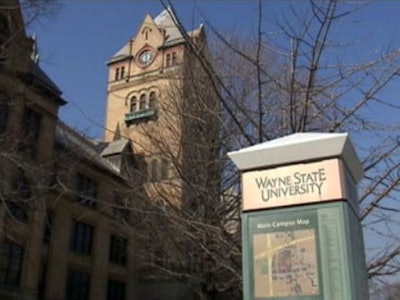
As the `what’s in, what’s out’ assessment slowly progresses, one thing seems certain: Wayne State University—the historic, public research institution of 28,000 multi-ethnic students that has called Detroit home for more than a century—shows no signs of abandoning ship.
“We are Detroit and Detroit is Wayne State,” said Ned Staebler, Wayne State’s vice president for economic development. “We’ve been here since 1868; we’ll be here [in] 2168,” he added, echoing the sentiments of the university’s leadership, including its board of trustees, its president and other administrators.
Confidence aside, Wayne State, located in the heart of they city, is closely following the issues relating to Detroit’s bankruptcy. The city’s plight has been the topic of countless informal water cooler conversations. The university’s Honors College course on American cities, which includes a special emphasis on Detroit, has woven the latest chapter of the city’ history into class discussions.
The city’s bankruptcy has also been the topic of least two university-wide forums, including one this week convened by former Wayne State President Dr. Irvin D. Reid. Dr. Reid led the institution for more than a decade until he retired in 2009.
Reed’s Forum on Contemporary Issues in Society (FOCIS) assembled Detroit Emergency Manager Kevyn Orr and Mayor-elect Mike Duggan with a panel of experts from across the country who have been working with other cities “that are in or emerging from significant financial stress, up to and including bankruptcy,” according to program information. “These voices from other places can teach us a lot about what citizens of Detroit may be facing for years to come,” the forum information flyer said.
“People who care about this place [Detroit] are very concerned,” said Wayne State Professor Dr. Jerry Herron, dean of the Honors College and a Wayne State faculty member for 31 years. “It’s our home.”
The city’s bankruptcy, said Herron, is “like a good friend who’s got in trouble. We want to help out.”
Herron noted that while the bankruptcy has had minimal immediate or direct impact on Wayne State, “people may be affected in a spin-off way.”
Indeed, there may be some spin-off” risks not yet seen.
As of 2010, some 26 percent of Wayne State’s more than 5,000 employees lived in the city. That means, in some way or another, they are dependent on the city’s public services, such as law enforcement, fire and emergency aid. Many of the other university employees commute to the city, relying on the same services in some way and, like residents, patronize retail stores, restaurants and visit cultural attractions like the famous Detroit Institute of Art (DIA).
Wayne State also provides educational opportunities for people in the city, from recent high school graduates to middle age and older adults who are retirees. The city has some 20,000 retirees whose pensions the city must deal with in the bankruptcy.
“A lot of those retirees are our neighbors, parents of students, and students themselves,” said Staebler. “They are real people—our families, friends and neighbors.”
Wayne State’s ability to avoid severe impact from the city’s collapse stems, in part, from the fact the university does not rely on the city to support it. In fact, since the city began its decline in the 1950’s, Wayne State has been increasingly providing the city help to sustain itself.
Over the past 15 years, Wayne State has invested more than $1 billion into rehabilitation and technological upgrading of existing facilities, construction of new facilities and acquisition of properties adjacent to its historic Cass Corridor campus.
Its housing inventory has risen to nearly 3,000 units from 1,000. Over the past four years, the university has taken on the role of city police in a four-square mile area surrounding the campus, a move that has seen crime in the covered neighborhoods drop by some 50 percent.
Wayne State has aggressively revisited its buying practices to try to help revive small businesses and help fight unemployment in the city, despite an overall population decline and persistently high joblessness. It has also offered mortgage help to employees who move to neighborhoods near the institution. Those who do can use the university shuttle bus system that circulates the area.
The university foresees no need to retreat on those efforts, despite the State of Michigan’s decision two years ago to cut spending at state institutions, including Wayne State, Michigan State University and the University of Michigan, by 15 percent.
“The bankruptcy isn’t becoming a wind to our face,” said Staebler, ticking off a list of actions the university made in the years and months before the bankruptcy to establish its role as one of the city’s anchors. “There are things we, as an anchor, can do and are working to do.”
In the past, the university made its faculty and staffers available to any city agencies that may have needed advice and consultation in specific fields like grant management and public safety. The same gesture is being made now, said Staebler and others at Wayne State.
At this point, said Staebler, the university realizes “everything is on the table” with regards to what plans the city will use to solve its financial problems, and Wayne State will have no official word in those decisions. By the same token, Staebler, a Detroit native, stresses, “as good public citizens [and] residents, we care deeply.”





















